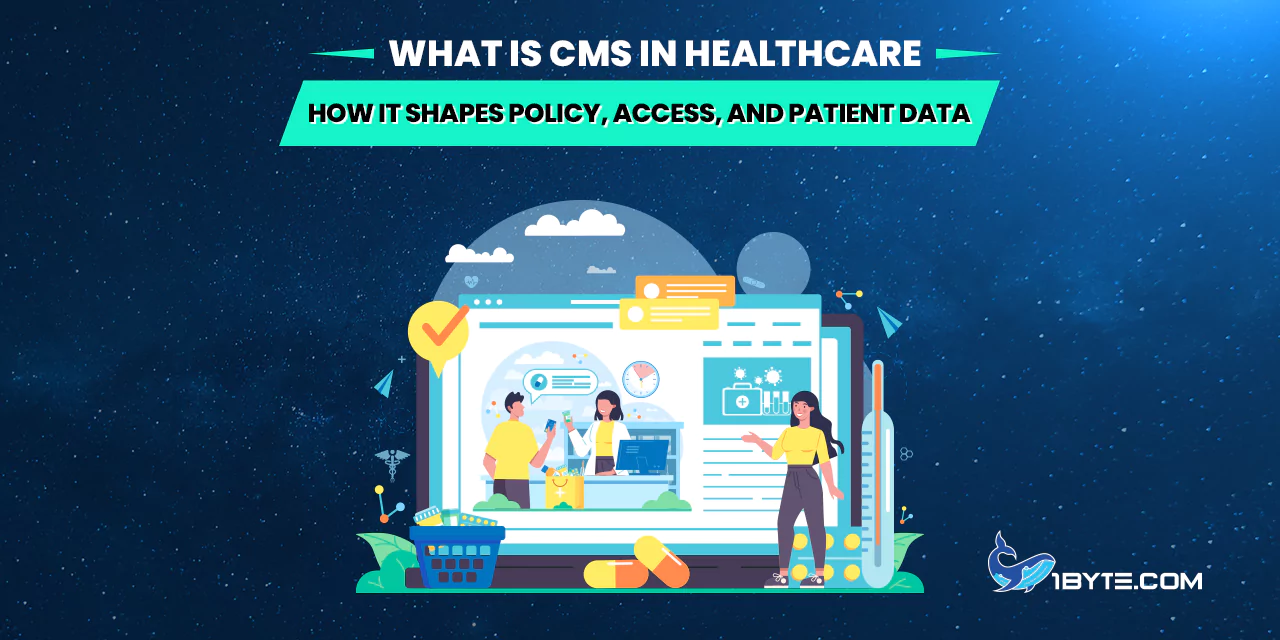Medical professionals receive and process huge volumes of electronic data on a daily basis. There should be good tools to keep this information organized and accessible. Many organizations are therefore asking what is CMS in healthcare and how it impacts the way they operate. In this regard, CMS means Content Management System (not to be confused with the U.S. agency) and it implies software systems that assist healthcare organizations in creating, managing, storing, and sharing digital content. These systems are central in the development of healthcare policy, access to information, and the management of patient data in a secure manner.
A content management system in healthcare allows fast access to information, makes it compliant (e.g. with HIPAA and ADA), and integrates with other systems, such as electronic health records (EHRs) and CRMs, to consolidate patient information. The modern healthcare CMS platforms perform several functions at the same time. They form the backbone of hospital websites and intranets, and a central point of all digital content and data. They make it possible to ensure that doctors, nurses, administrators, and even patients can receive the right information at the right time. In addition, they implement data policies and privacy regulations in the background and even connect to clinical systems to retrieve current patient records. Read this article on 1Byte to know more.
Understanding Content Management Systems in Healthcare
A healthcare content management system is a specific software system that manages the content requirements of healthcare organizations. Generally speaking, a CMS offers the online platform to develop, modify and publish the content on websites or internal networks. This content in healthcare context may be as simple as educational articles on a hospital web site, electronic forms, policy documents, and even components of patient medical records. In the essence of it, a healthcare CMS enables a centralized management of content creation and data governance.

The difference between a healthcare CMS and other CMS is that it is compliance and integration-oriented. Healthcare professionals should be able to deliver proper health information to the patients and the staff in a timely manner. An effective CMS will enable one to easily update the site of a clinic with the latest treatment guidelines or even post urgent announcements. Another important element is compliance, which means that a healthcare CMS can facilitate compliance with regulations such as the Health Insurance Portability and Accountability Act (HIPAA) in the U.S. and accessibility laws such as the Americans with Disabilities Act (ADA). As an example, the CMS can impose the rules like the one that the patient data should be encrypted and only available to the authorized people, which can help protect confidential information according to the HIPAA standards. It also allows to add accessibility features (such as text alternatives to images and keyboard navigation) to make sure that patients with disabilities can access online services, which is also in accordance with ADA guidelines.
Clinical systems integration is another characteristic of healthcare CMS platforms. They tend to interface with electronic health record (EHR) systems, customer relationship management (CRM) tools, and other databases. This integration eliminates information silos since the CMS can extract data stored in different sources into a single location. As an example, the CMS of a hospital may be connected to its EHR such that when a physician makes changes to a patient record, the secure portal of the patient (which is managed by the CMS) automatically displays the new test results. A CMS can connect these systems so that all the patient and stakeholder data remains structured and current on a single interface. This is a very important approach in the field of healthcare where a disjointed system may cause data fragmentation.
FURTHER READING: |
| 1. Content Management System (CMS): Choosing the Right CMS for Your Business |
| 2. Top 5 Best CMS for eCommerce in 2025 |
| 3. The Ultimate Website Migration Guide in 2025 |
Shaping Policy and Compliance Through CMS
The use of data, patient privacy, and information security are under strict policies and regulations in healthcare organizations. The direct support of these policies in a content management system in healthcare is achieved by incorporating the compliance functionality into the technology. The policies of data governance (the rules of the data treatment and access) are frequently implemented through the settings of the CMS and user roles. Certain content can be viewed or edited by the right people only. As an illustration, a safe healthcare CMS will have role-based access controls that only authorize the staff members to view or edit confidential patient data. It will also have powerful data encryption of any patient data both when stored and when being transmitted, which will minimize the chances of unauthorized access in the case of digital transfers. Such in-built security measures assist medical practitioners in adhering to the HIPAA requirements of safeguarding patient health information.
In addition to privacy, content management systems assist in data retention, audit trail, and accountability policies. They maintain records of what was edited by whom and when which is necessary in auditing and legal requirements of data management in healthcare. Large CMS vendors usually enter Business Associate Agreements (BAAs) with healthcare institutions, promising to manage data about patients properly and in accordance with HIPAA. This decentralizes responsibility and makes sure that even the third party software providers are following healthcare data protection policies.
Broader National Policies and Initiatives
Moreover, healthcare CMS tools align with broader national policies and initiatives aimed at improving data sharing and patient rights. In recent years, laws like the 21st Century Cures Act and related rules have pushed for greater interoperability and patient access to health information. For instance, a federal rule in 2020 required secure, standardized APIs so that patients can easily access their medical records through apps. Content management systems in healthcare play a role here by providing the infrastructure to share data when appropriate. They enable hospitals to publish APIs or portals that meet these government standards, effectively turning policy mandates into practical tools for patients. In other words, as healthcare policies evolve to demand more transparency and data exchange, CMS platforms are adapted to fulfill those requirements.
The use of CMS also influences policy on an organizational level. The introduction of a centralized content system in a hospital tends to result in standardization of the way information is managed across departments. It becomes easy to implement internal policies on content approval, updates, and archiving since all the content is going through a single system. This decreases the possibility of having outdated clinical guidelines floating around or inconsistent patient education materials in use. All people adhere to the same procedures incorporated in the CMS This has the effect of baking the policies governing the operation of the organization into the content management workflow, such as how frequently to update a consent form, how to verify information before publishing, etc. Such control and standardization has the potential to enhance the quality of care and minimize errors, as staff always has access to the most up-to-date, approved information.
To exemplify, one can refer to the rapid changes in healthcare guidelines that occurred during the COVID-19 pandemic. Hospitals with well-developed content management systems would be able to revise their websites and internal portals with new visitor restriction policies or personal protective equipment. The CMS allowed these updates to be made and pushed live rapidly and in a uniform manner across all locations so that staff and patients were kept up to date. There are transition words such as meanwhile and furthermore scattered throughout the process: one team of people can update the policy in the CMS, and meanwhile, another group can add patient FAQs to the website. Moreover, since the CMS monitors changes, the management can see what information was given at any particular time, which is helpful in accountability. Overall, a healthcare CMS defines policy by converting regulatory and organizational needs into the daily management of digital content.
Improving Access to Information with CMS
The accessibility of healthcare information to both the patient and the provider is also enhanced significantly by the use of content management systems. Previously, a patient could wait and receive a phone call or a letter to obtain his or her lab results. Nowadays, with the help of patient portals (which are usually driven by CMS technology), patients are able to log in to their portal and view their test results, medication instructions, or notes left by their doctor as soon as they are available. This has resulted in an upsurge in patient access to their own health information. In the U.S., approximately three out of every five people said that they had viewed their online medical record or patient portal in 2022, which is a 50 percent increase since 2020. Indeed, about 75 percent of individuals were provided with the opportunity to use an online portal by their insurer or healthcare provider in 2022 (compared to approximately half two years earlier). This trend demonstrates the speed at which digital access is becoming a normal component of healthcare, and content management systems are one of the technologies that enable it.

A properly executed CMS is convenience and empowerment to the patient. They are able to get answers to frequently asked questions on the FAQ page of a clinic, complete forms online, or get updates using a mobile application. When a hospital has a site constructed on an up-to-date CMS, it will most probably be mobile-responsive and user-friendly, which is significant because a significant number of patients use smartphones to obtain information. The CMS assists in maintaining the information such as clinic hours, services provided, and educational articles up-to-date and always displayed. Furthermore, CMS platforms have accessibility features (such as text-to-speech compatibility or font size adjustment) that ensure that the information needed by patients of all abilities is accessible. This comprehensive strategy enhances access and patient satisfaction further.
For Healthcare Professionals
For healthcare professionals, the access benefits are just as significant. Consider a doctor who needs to review a patient’s history, including records from different departments (such as radiology images, lab results, and referral notes). If each department had its own isolated system, the doctor might have to log in to multiple applications or request information be sent over – a time-consuming process that could delay care. However, when an organization uses a unified content management or data management system, it can aggregate all of that patient information in one place. For example, Tirol Kliniken in Austria implemented an enterprise imaging and data management system that consolidates patient data from across its entire network. This central archive holds nearly all images and multimedia data from five sites, integrating data from more than 250 subsystems spanning over 100 different vendors. Clinicians at Tirol Kliniken can use this single system (either on-site or via the web) to access patient data from multiple sources at once, giving them a comprehensive, patient-centric view of all relevant information. As one surgeon there noted, this kind of tight integration allows for a holistic view of the patient’s data, which improves trust in the information and supports better care decisions.
These are some of the instances that illustrate the CMS-driven integration that enhances access to providers. Conversely, data that is scattered in different systems makes access and coordination difficult. According to an article on healthcare CMS challenges, fragmentation of data becomes an issue when various departments have various content systems, and it is challenging to aggregate patient records, which results in inefficiencies and even possible errors in diagnosis or treatment. A CMS makes it possible to have all the information needed by the caregivers without having to do any hoop-jumping by enhancing interoperability and uniting data. This instant access is not only time-saving but also improves the quality of care- doctors are making more informed decisions when they have the complete picture of a patient history.
Moreover, the increased access to information through CMS is also applicable to public health messaging and patient education. Healthcare organizations usually utilize their websites and content platforms to share valuable information (such as vaccine schedules, health advisories, or wellness tips). A CMS makes it possible to make fast changes to these messages and target them to a given group of patients. As an example, a clinic might display a custom banner regarding flu shot clinics to only those users in high-risk age groups who have a profile. Such individualized content delivery is becoming more of a possibility as CMS systems become more connected with CRMs and analytics. It implies that patients receive the information that is most pertinent to them, and the most important health information is less likely to be lost in the mix. All in all, content management systems have changed the process of accessing health information, which was slow and paper-based to a digital experience that is instantaneous.
Managing and Protecting Patient Data
The most important task of a healthcare CMS is, perhaps, the way it influences the processing of patient data. Healthcare data is not just very sensitive, it is also massive in size. Health care industry is generating mind-blowing volumes of data; one estimate suggests that it generates almost a third of the global data. Each patient admission, lab test, imaging scan, and electronic prescription is part of this data deluge. The task of handling such huge amounts of information is an overwhelming one and this is where content management systems come in handy.
A Framework for Organization

A healthcare-specific CMS offers a system to store and access patient information in an effective way. It saves data in structured forms and it frequently employs metadata (such as tags of patient ID, date, department, etc.) to facilitate searching. A hospital may not be able to locate a particular document out of millions without a good system. In the words of one IT director, it would be, quite literally, impossible to cope with hundreds of gigabytes of new data every day without the powerful tools. Healthcare organizations can guarantee that the necessary information about the patient is accessible and at the right time and place, be it a doctor accessing a past MRI or a nurse checking an allergy recorded last year by using powerful content and data management platforms.
Interoperability
The other important factor is interoperability, the capability of various software and systems to exchange data with one another. The experience of a patient in the healthcare system may involve numerous systems labs, pharmacies, imaging centers, specialist clinics, all of which create their own records. These disparate pieces can be collected by a content management system that follows interoperability standards (such as HL7 FHIR or DICOM in the case of imaging). This centralization of information on the patient instead of on a department by department basis is a best practice that is developing in contemporary healthcare IT. CMS solutions allow removing silos by prioritizing patient-centric data management. Practically, it implies that a clinician can be sure that the information presented in the CMS is complete and current and is based on all the sources linked in real-time.
Security
Patient data management cannot exist without security. Data breaches in healthcare are not only expensive but also hazardous, and a CMS should have robust security features. We have already touched on encryption and access controls as part of compliance, but in addition to preventing unauthorized access, a CMS also preserves data integrity. It does not lose data because it has backups and audit trails. Most healthcare CMS systems provide disaster recovery services, such as frequent backups to a secure cloud, so that even in case of a hardware failure or cyberattack, patient records are not lost. They also maintain version history, so in case an error is made (a typo in a patient file or a wrong document uploaded), it can be reverted or fixed without much trouble. All these safeguards are in place to make sure that the data of the patients is confidential, accessible, and correct, which is what is commonly known as the CIA triad of information security (Confidentiality, Integrity, Availability).
The effect of effective management of patient data is extensive. Once data is consolidated and secure, healthcare providers can begin to use it as a strategic asset. They are able to interpret trends, optimize workflows and even utilize new technologies such as artificial intelligence in their CMS to derive insights. Actually, technology is making healthcare CMS smarter. In some of the contemporary systems, AI algorithms are used to automatically classify content or identify abnormal trends in patient data. To illustrate, an AI-enhanced CMS could highlight a set of symptoms and test results in the record of a patient that indicates a rare condition, so that it does not go unnoticed by the clinician. These are all developments that are still in their infancy, but they are indicative of a future where content management systems not only store data but also assist in its interpretation. An effective management of patient data by a CMS preconditions improved care outcomes, research, and innovation.
Benefits and Challenges of Healthcare CMS
The implementation of a content management system in healthcare is associated with a lot of advantages, yet it is not devoid of difficulties.
Benefits
On the positive side, we have already mentioned some of them: better efficiency in information retrieval, more compliance and security, increased patient engagement via portals, and improved provider coordination. In conclusion, an effective CMS has the potential to optimize the workflow within a healthcare organization. Tasks that are common such as updating a form or sending out a new policy are quicker and less likely to be inaccurate since they can be accomplished in a single platform. Care teams do not spend time chasing information and more time on patients. Personalized patient care is also facilitated by a CMS, as it enables a more comprehensive picture of a patient to be formed through the integration of data, which can lead to better decision-making and fewer duplicate tests or conflicting treatments. All these mean cost savings and improved patient outcomes in the long term, which is the end goal of any healthcare technology.
The organizational benefits are also wider. Branding and consistent content on all the patient touchpoints (website, mobile app, emails) enhance the credibility of the healthcare provider. Patients will develop trust when they are able to see current information and receive prompt answers (such as an automated appointment reminder or a notification of a new test result). Internally, a good digital system can eliminate frustrating paperwork bottlenecks and thus raise staff morale. Also, having extensive data management, administrators will be able to create reports and analytics that will be used to make strategic decisions (e.g., which clinic locations receive the most appointment requests online, or which educational content patients consider most useful).
Challenges
Conversely, there may be challenges, particularly when an organization has several older systems. The first problem is data fragmentation where various departments have traditionally used different software. It can be technically challenging to introduce a new CMS and to consolidate everything. As has been mentioned above, fragmentation contributes to inefficiencies and may impede care coordination. To overcome this, it may take a lot of work in data migration and cleansing to get all the legacy data into the new system in the right way. The other issue is interoperability; not every system communicates with one another easily. In case the EHR or lab system of a clinic is not seamlessly integrated with the new CMS, custom interfaces or middleware may be required, which are expensive and time-consuming to create.

There are also considerations of cost and resources. The deployment of a high-quality healthcare CMS requires investment in software licenses or subscriptions, hardware (in case of on-premises), and training of personnel. Maintenance and update costs may be incurred. The cost may be a challenge to smaller practices but the cloud-based options of healthcare CMS are making the systems affordable as they do not require heavy in-house IT infrastructure. In reality, cloud solutions are capable of reducing upfront costs and providing more flexibility as they can be accessed anywhere, and can scale storage or features as needed. Nevertheless, the decision-makers should consider the short-term disturbance and the long-term benefits. Notably, it is essential to train staff: without making users feel comfortable with the new system, the investment will not pay off to the full extent. Ongoing training and assistance during and after the implementation of a CMS has been cited as instrumental to success. It requires time and leadership support as people have to learn new workflows and trust the system.
In this respect, data security is a two-edged sword. Although a CMS can enhance security through centralized controls, when not configured in a proper manner, it may as well be a single point of failure. The attack on a single system may be far-reaching. As such, healthcare organizations need to thoroughly vet CMS vendors in terms of security certifications and compliance. They must also ensure that the system is patched by updating it. The task is continuous, because cyber threats are dynamic. However, the industry opinion is that the solution to security is not to remain in the paper world or to have a dozen unconnected databases instead, it is to select modern systems and to implement strong security controls across the board.
Latest Trends and Statistics in Healthcare CMS
The use of content management systems in healthcare is growing rapidly, reflecting the broader digital transformation of the industry. Recent market research shows that the healthcare CMS market is expanding at a healthy pace. Globally, this market (often called healthcare content management or healthcare enterprise content management) is projected to climb from about $28–29 billion in 2024 to over $50 billion by 2032, roughly an annual growth rate in the double digits. Some analyses even predict it could reach around $100 billion by the mid-2030s if trends continue. This growth is driven by several factors. One is the widespread adoption of electronic health records – with so much patient data now being digital, hospitals need robust content management solutions to handle it. Another factor is the increasing focus on patient-centered care and engagement: healthcare providers are investing in systems that support patient portals, personalized health content, and two-way communication, all of which are facilitated by CMS technology.
Interoperability standards are also maturing and increasing the use of CMS. Data exchange protocols such as Fast Healthcare Interoperability Resources (FHIR) and other data exchange standards are becoming widespread, and it is becoming easier to exchange data between different systems. This has made healthcare organizations more certain when it comes to implementing new CMS platforms that can integrate with their current environment without data isolation. Another trend is cloud based CMS. In 2023, the multi-tenant cloud deployments (where the CMS is hosted on the web and served to multiple users) had a higher market share due to cost reduction and scalability. Nevertheless, there are providers who still favor single-tenant environments (dedicated infrastructure) to have more control and security, a preference that may increase as data privacy issues remain top of mind.
The second trend is the integration of modern technologies such as AI and machine learning into the content management. As an example, AI can be used to automatically tag and organize the content, detect anomalies in health records, or even suggest content personalization of patient education materials. These features are still under development, but they are beginning to distinguish the next generation of healthcare CMS platforms. There is also a trend towards modularity and flexibility, hospitals want systems they can customise to their particular requirements by adding modules to cover things like telehealth video content, appointment scheduling interfaces, or inventory management of their medical content (such as image libraries). Vendors are countering by providing more modular architectures
In terms of statistics, it is evident that the delivery of digital content has become part of patient experience. The use of telehealth has skyrocketed over the past couple of years, and this is in tandem with patient portal use. Telemedicine is expected to have a market size of hundreds of billions by 2030, which means that a huge amount of consultations and health data will be transmitted through digital channels. In line with this, most healthcare providers (more than 90 percent of hospitals in the United States according to some reports) now allow their patients to view their medical records online. The next step is to make a better use of these tools, which is not happening yet, with approximately 40 percent of patients failing to use portals available to them, sometimes because of ignorance or usability problems. It is likely that CMS-driven interfaces will be improved and that patients will be educated on how to use them.
In conclusion of the trends, the healthcare CMS market is expanding, evolving, and increasingly becoming a focus of healthcare delivery. Hospitals of all sizes are realizing that content and data management is not an IT issue, but a strategic issue in a world where information can literally be life saving.
Leverage 1Byte’s strong cloud computing expertise to boost your business in a big way
1Byte provides complete domain registration services that include dedicated support staff, educated customer care, reasonable costs, as well as a domain price search tool.
Elevate your online security with 1Byte's SSL Service. Unparalleled protection, seamless integration, and peace of mind for your digital journey.
No matter the cloud server package you pick, you can rely on 1Byte for dependability, privacy, security, and a stress-free experience that is essential for successful businesses.
Choosing us as your shared hosting provider allows you to get excellent value for your money while enjoying the same level of quality and functionality as more expensive options.
Through highly flexible programs, 1Byte's cutting-edge cloud hosting gives great solutions to small and medium-sized businesses faster, more securely, and at reduced costs.
Stay ahead of the competition with 1Byte's innovative WordPress hosting services. Our feature-rich plans and unmatched reliability ensure your website stands out and delivers an unforgettable user experience.
As an official AWS Partner, one of our primary responsibilities is to assist businesses in modernizing their operations and make the most of their journeys to the cloud with AWS.
Conclusion
A content management system in healthcare is not merely a web-site tool, but a core technology that defines policy, access, and patient data management in the contemporary healthcare. By asking what is CMS in healthcare, we uncover how these systems weave into nearly every aspect of healthcare operations. They make sure that laws and standards are met and hence the translation of policy into practice. They provide access, which gives patients information and assists clinicians in having complete data at their fingertips. They sort and protect patient data at an unprecedented level, converting what might be an unmanageable deluge of information into a manageable asset in care enhancement.
CMS platforms have become irreplaceable in the healthcare industry that is currently undergoing digital transformation. They not only assist hospitals and clinics to stay on track with regulatory requirements and patient expectations but also precondition the future innovations. Whether it is the power to facilitate telehealth and personalized medicine, the ability to enhance big data analytics and AI-based insights, a powerful CMS is often the unsung hero that helps make these innovations a reality. This is not a smooth ride, there are problems such as interoperability, costs and user adoption that have to be planned and managed. The trend is however evident: the content management systems in the field of healthcare are developing and changing, similarly to the field of healthcare itself, and the end goal is the improvement of patient outcomes and the efficiency of the health system.
In summary, what is CMS in healthcare? It is the engine behind the scenes that makes the intricate web of healthcare information. It influences the way policies are implemented on a daily basis, the ease of access of crucial information by both the patients and the providers, and the security and efficiency of management of that patient information. According to the new statistics and trends, the use of healthcare CMS is increasing at a very high rate, which proves that these systems are defining the future of healthcare delivery. By adopting a properly planned content management system, healthcare organizations can enter the digital era with confidence, and be assured that their information is available, trustworthy, and applied in the pursuit of quality care to everyone.

